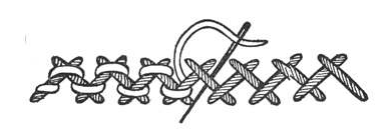
Next up in our Stitch Directory is the Herringbone Stitch. This stitch looks just like its name suggests! It’s worked in lines and is particularly useful for borders, and for covering seams where two pieces of fabric have been joined together.

You can closely work this stitch to provide coverage or it can be more widely spaced and it achieves very quick results. Working from right to left along an imaginary double line, bring your thread out at A. Insert your needle a little to the right on the upper line at B and then bring it to the front again at C. Now return to the lower line and insert your needle at D, bringing it to the front again at E. Then simply repeat these steps. It’s really important to keep this stitch evenly spaced as otherwise it will look very messy.

Threaded herringbone stitch creates a very pretty border, especially if you choose a different coloured thread. First stitch a row of ordinary herringbone stitch, then lace a second length of thread as shown in the diagram above. Your needle doesn’t enter the fabric for this threading process, but is laced upwards and downwards through the foundation stitches. Your thread should cover the foundation stitches at the point where they cross
I do hope that you’ve found this post useful, pop back next week when we’ll be looking at the Lazy Daisy Stitch!
*If you missed last week’s post about French Knots you can find it here.*
Leave a Reply